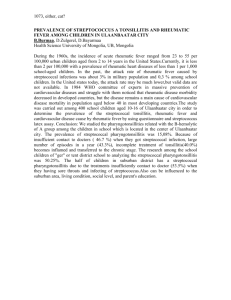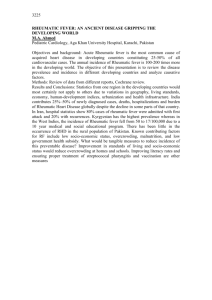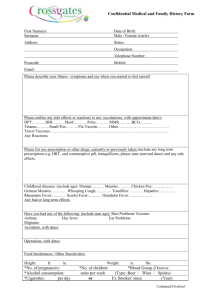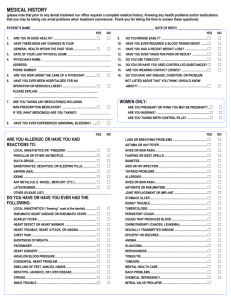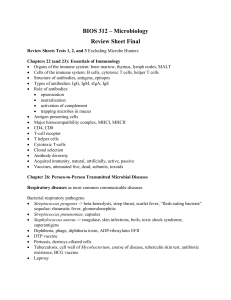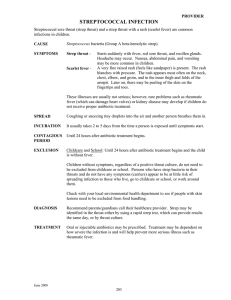Unit 4 Part 3 Streptococcal Serology Terry Kotrla, MS, MT(ASCP)BB
advertisement
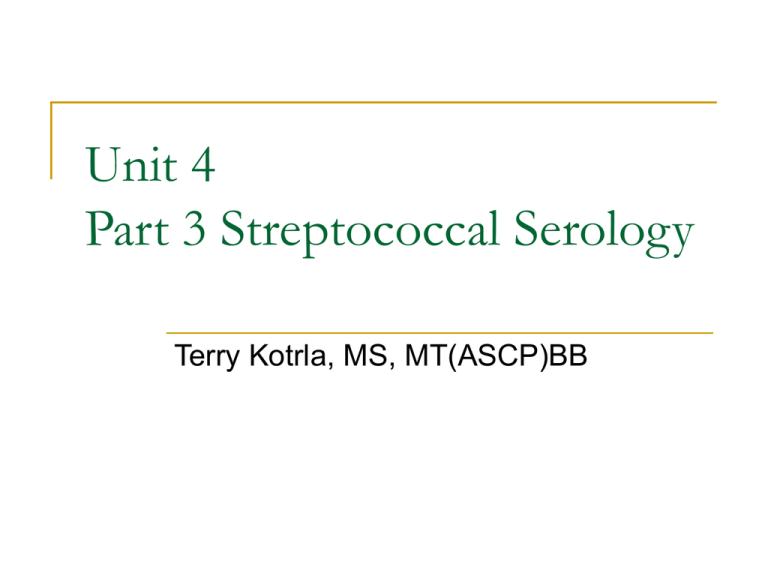
Unit 4 Part 3 Streptococcal Serology Terry Kotrla, MS, MT(ASCP)BB Introduction Gram-positive Beta hemolytic Spherical, ovoid or lancet shaped Pairs or chains Divided into Serotypes or groups Two major outer proteins M and T Interior proteins divided into 20 defined groups known as Lancefield groupings A-H and K-T. Streptococcus pyogenes belong to Lancefield group A M protein chief virulent factor Numerous Exoantigens Exoantigens are produced and excreted and include: Streptolysin O Dnase Hyaluronidase Nicotinamide Adenine Dinucleotidase Streptokinase Patients react to exoantigens by producing antibodies Streptococcus pyogenes Organism found only in man. Leading cause of oropharyngitis which may lead to serious complications (sequelae) Rheumatic fever Acute glomerulonephritis Culture and rapid screening tests detect early infection. Characteristics Two major sites of infection Upper respiratory tract Skin Upper Respiratory Sore Throat Tonsillar exudate Fever Chills Headache 20% school children carriers Skin Pyoderma or Impetigo Lesions on extremities Commonly on face Pustular and crusty Suppurative Complications Suppurate -To generate pus; as, a boil or abscess suppurates. Erysipelas Cellulitis Necrotizing fasciitis Scarlet fever Puerperal sepsis Erysipelas Erysipelas produces a rash that is red, slightly swollen, with very defined borders (well demarcated), warm, and tender to the touch. In this photograph, the right cheek is involved. There may be symptoms that affect the entire body (systemic) including fever and chills. Cellulitis Diffuse inflammation of connective tissue with severe inflammation of dermal and subcutaneous layers of skin. Skin on face or lower leg most common site, but can occur anywhere on body. Necrotizing Fasciitis – rare infection of deeper layers of skin and subcutaneous tissue Scarlet Fever Strawberry tongue Strep bacteria produces a toxin that causes a rash Appears 12-48 hours after fever Sandpapery Peels Suppurative Complications Septic arthritis Acute bacterial endocarditis Meningitis Toxic shock-like syndrome Non-Suppurative Complications Inflammatory response elsewhere in the body. Damaging sequelae to strep infection Rheumatic Fever Post-Streptococcal glomerulonephritis Rheumatic Fever Only certain serotypes involved. Delayed consequence of an untreated upper respiratory infection with group A streptococci in 23% of population. Not well understood. Symptoms occur 20 days after sore throat. Causes serious, debilitating damage to the heart. Associated with large amount of M protein and a capsule Rheumatic Fever Due to immune response against Strep antigens similar to heart antigens. Inflammation of the mitral valve the most serious. Thirty to 60% of patients suffer permanent disability. Rheumatic Fever This is the heart of a 44 year old woman who had rheumatic fever and had been treated for congestive heart failure for about one year. Poststreptococcal glomerulonephritis Follows strep infection of skin or pharynx. Occurs about 10 days following initial infection. Characterized by damage to glomeruli of kidneys. Inflammatory response causes damage. Post-Streptococcal Glomerulonephritis Deposition of Ag-Ab complexes, activation of complement. Complement activated resulting in hypocomplementemia. Renal function impaired due to reduction in glomerular filtration rate, results in edema and hypertension. Renal failure not typical. Poststreptococcal glomerulonephritis Most common in children 2-12 Symptoms: Hematuria Proteinuria Edema hypertension Poststreptococcal glomerulonephritis The scattered capillary wall granular deposits in acute poststreptococcal glomerulonephritis also stain for complement (immunofluorescence with antibody to C3) Laboratory Testing Culture and identification Rapid Strep Tests from throat swab Detection of Streptococcal antibodies Anti-Streptolysin O (ASO) titer DNA probes Rapid Strep Tests from throat swab Antigen from a swab is extracted. Test extracted antigens using ELISA or latex agglutination. If negative perform C&S. Detection of Streptococcal Antibodies Most useful in Streptococcal sequelae Organisms elaborate more than 20 exotoxins that may invoke antibody response. Most useful antibodies are: Anti-Streptolysin O (ASO) Anti-DNase B Anti-NADase Anti-Hyaluronidates Detection of Streptococcal Antibodies Serological evidence of disease is based on elevated or rising titer of Streptococcal antibodies. Four fold (2 tube dilution) rise in titer is considered clinically significant. Anti-Streptolysin O (ASO) titer Two of the toxins produced are Streptolysin S, which is oxygen stable, nonantigenic and Streptolysin O (SLO), which is oxygen labile and antigenic. SLO is a hemolysin which is toxic to many tissues, including heart and kidneys. Evokes an antibody response (anti-SLO) which neutralizes the hemolytic action of SLO. Specific for ASO, it does not test for antibodies to any other Streptococcal exotoxins. Anti-DNase B Testing May appear earlier than ASO. Increased sensitivity for detection of glomerulonephritis preceded by streptococcal skin infections. Macro- and micro-titer, ELISA and neutralization techniques are available. Neutralization technique has advantage of stability of reagents. DNA Probes Sensitive and specific Takes less time, hours versus days Many methods developed but principle the same. PCR Add specific primers (probes) with tag Tag gives off signal, ie, fluorescence The End


